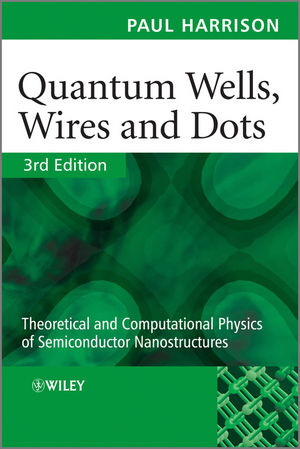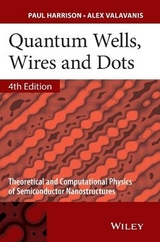
Quantum Wells, Wires and Dots
Wiley-Blackwell (Verlag)
978-0-470-77098-6 (ISBN)
- Titel ist leider vergriffen;
keine Neuauflage - Artikel merken
Quantum Wells, Wires and Dots, 3rd Edition is aimed at providing all the essential information, both theoretical and computational, in order that the reader can, starting from essentially nothing, understand how the electronic, optical and transport properties of semiconductor heterostructures are calculated. Completely revised and updated, this text is designed to lead the reader through a series of simple theoretical and computational implementations, and slowly build from solid foundations, to a level where the reader can begin to initiate theoretical investigations or explanations of their own.
Paul Harrison is currently working in the Institute of Microwaves an photonics (IMP), which is a research institute within the School of Electronic and Electrical Engineering at the University of Leeds in the United Kingdom. he can always be fond on the web, at the time of writing at: http://www.ee.leeds.ac.uk/homes/ph/ and always answers email. Currently he can be reached at: p.harrison@leeds.ac.uk or p.harrison@physics.org Paul is working on a wide variety of projects, most of which centre around exploiting quantum mechanics for the creation of novel opto-electronic devices, largely, but not exclusively, in semiconductor Quantum Wells, Wires and Dots. Up-to-date information can be found on his web page. He is always looking for exceptionally well-qualified and motivated students to study for a PhD degree with him-if interested, please don't hesitate to contact him. Zoran Ikonic was Professor at the University of Belgrade and is now also a researcher in the IMP. His research interests and experience include the full width of semiconductor physics and optoelectronic devices, in particular, band structure calculations, strainlayered systems, carrier scattering theory, non-linear optics, as well as conventional and quantum mechanical methods for device optimization. Vladimir Jovanovic completed his PhD at the IMP on physical models of quantum well infrared photodetectors and quantum cascade lasers in GaN- and GaAs-based materials for near-, mid- and far-infrared (terahertz) applications. Marco Califano is a Royal Society University Research Fellow bas3ed in the IMP at Leeds whose main interests focus on atomistic Pseudopotential modelling of the electronic and optical properties of semiconductor nanostructures of different materials for applications in photovoltaics. Craig A. Evans completed his PhD on the optical and thermal properties of quantum cascade lasers in the School of Electronic and Electrical Engineering, University of Leeds in 2008. He then worked as a Postdoctoral Research Assistant in the IMP working in the field of rare-earth doped fibre lasers and integrated photonic device modelling and has now joined the staff of the school. Dragan Indjin is an Academic Research Fellow in the IMP and has research interests in semiconductor nanostructures, non-linear optics. quantum computing and spintronics.
Preface. Acknowledgements. About the author(s). About the book. Introduction. 1 Semiconductors and heterostructures. 1.1 The mechanics of waves. 1.2 Crystal structure. 1.3 The effective mass approximation. 1.4 Band theory. 1.5 Heterojunctions. 1.6 Heterostructures. 1.7 The envelope function approximation. 1.8 The reciprocal lattice. 2 Solutions to Schrodinger's equation. 2.1 The infinite well 2.2 In-plane dispersion 2.3 Density of states 2.4 Subband populations 2.5 Finite well with constant mass 2.6 Effective mass mismatch at heterojunctions 2.7 The infinite barrier height and mass limits 2.8 Hermiticity and the kinetic energy operator 2.9 Alternative kinetic energy operators 2.10 Extension to multiple-well systems 2.11 The asymmetric single quantum well 2.12 Addition of an electric field 2.13 The infinite superlattice 2.14 The single barrier 2.15 The double barrier 2.16 Extension to include electric field 2.17 Magnetic fields and Landau quantisation 2.18 In summary 3 Numerical solutions. 3.1 Shooting method 3.2 Generalised initial conditions 3.3 Practical implementation of the shooting method 3.4 Heterojunction boundary conditions 3.5 The parabolic potential well 3.6 The Poschl-Teller potential hole 3.7 Convergence tests 3.8 Extension to variable effective mass 3.9 The double quantum well 3.10 Multiple quantum wells and finite superlattices 3.11 Addition of electric field 3.12 Quantum confined Stark effect 3.13 Field-induced anti-crossings 3.14 Symmetry and selection rules 3.15 The Heisenberg uncertainty principle 3.16 Extension to include band non-parabolicity 3.17 Poisson's equation 3.18 Self-consistent Schrodinger-Poisson solution 3.19 Computational implementation 3.20 Modulation doping 3.21 The high-electron-mobility transistor 3.22 Band filling 4 Diffusion. 4.1 Introduction 4.2 Theory 4.3 Boundary conditions 4.4 Convergence tests 4.5 Constant diffusion coefficients 4.6 Concentration dependent diffusion coefficient 4.7 Depth dependent diffusion coefficient 4.8 Time dependent diffusion coefficient 4.9 delta-doped quantum wells 4.10 Extension to higher dimensions 5 Impurities. 5.1 Donors and acceptors in bulk material 5.2 Binding energy in a heterostructure 5.3 Two-dimensional trial wave function 5.4 Three-dimensional trial wave function 5.5 Variable-symmetry trial wave function 5.6 Inclusion of a central cell correction 5.7 Special considerations for acceptors 5.8 Effective mass and dielectric mismatch 5.9 Band non-parabolicity 5.10 Excited states 5.11 Application to spin-flip Raman spectroscopy 5.12 Alternative approach to excited impurity states 5.13 The ground state 5.14 Position dependence 5.15 Excited States 5.16 Impurity occupancy statistics 6 Excitons. 6.1 Excitons in bulk 6.2 Excitons in heterostructures 6.3 Exciton binding energies 6.4 1s exciton 6.5 The two-dimensional and three-dimensional limits 6.6 Excitons in single quantum wells 6.7 Excitons in multiple quantum wells 6.8 Stark Ladders 6.9 Self-consistent effects 6.10 Spontaneous symmetry breaking 6.11 2s exciton 7 Strained quantum wells, V. D. Jovanovic. 7.1 Stress and strain in bulk crystals 7.2 Strain in quantum wells 7.3 Strain balancing 7.4 Effect on the band profile of quantum wells 7.5 The piezoelectric effect 7.6 Induced piezoelectric fields in quantum wells 7.7 Effect of piezoelectric fields on quantum wells 8 Simple models of quantum wires and dots. 8.1 Further confinement. 8.2 Schrodinger's equation in quantum wires. 8.3 Infinitely deep rectangular wires. 8.4 Simple approximation to a finite rectangular wire. 8.5 Circular cross-section wire. 8.6 Quantum boxes. 8.7 Spherical quantum dots. 8.8 Non-zero angular momentum states. 8.9 Approaches to pyramidal dots. 8.10 Matrix approaches. 8.11 Finite difference expansions. 8.12 Density of states. 9 Quantum dots, M. Califano. 9.1 0-dimensional systems and their experimental realization. 9.2 Cuboidal dots. 9.3 Dots of arbitrary shape. 9.4 Application to real problems. 9.5 A more complex model is not always a better model. 10 Carrier scattering. 10.1 Fermi's Golden Rule. 10.2 Phonons. 10.3 Longitudinal optic phonon scattering of bulk carriers. 10.4 LO phonon scattering of two-dimensional carriers. 10.5 Application to conduction subbands. 10.6 Averaging over carrier distributions. 10.7 Ratio of emission to absorption. 10.8 Screening of the LO phonon interaction. 10.9 Acoustic deformation potential scattering. 10.10 Application to conduction subbands. 10.11 Optical deformation potential scattering. 10.12 Confined and interface phonon modes. 10.13 Carrier-carrier scattering. 10.14 Addition of screening. 10.15 Averaging over an initial state population. 10.16 Intrasubband versus intersubband. 10.17 Thermalised distributions. 10.18 Auger-type intersubband processes. 10.19 Asymmetric intrasubband processes. 10.20 Empirical relationships. 10.21 Carrier-photon scattering. 10.22 Carrier scattering in quantum wires and dots. 11 Electron transport. 11.1 Introduction. 11.2 Mid-infrared quantum cascade lasers. 11.3 Realistic quantum cascade laser. 11.4 Rate equations. 11.5 Self-consistent solution of the rate equations. 11.6 Calculation of the current density. 11.7 Phonon and carrier-carrier scattering transport. 11.8 Electron temperature. 11.9 Calculation of the gain. 11.10 QCLs, QWIPs, QDIPs and other methods. 12 Optical properties of quantum wells, D. Indjin. 12.1 Intersubband absorption in quantum wells. 12.2 Bound-bound transitions. 12.3 Bound-free transitions. 12.4 Fermi level. 12.5 Rectangular quantum well. 12.6 Intersubband optical non-linearities. 12.7 Electric polarisation. 12.8 Intersubband second harmonic generation. 12.9 Maximization of resonant susceptibility. 13 Optical waveguides, C. A. Evans. 13.1 Introduction to optical waveguides. 13.2 Optical waveguide analysis. 13.3 Optical properties of materials. 13.4 Application to waveguides of laser devices. 14 Multiband envelope function (k.p) method, Z. Ikonic. 14.1 Symmetry, basis states and band structure. 14.2 Valence band structure and the 6 x 6 Hamiltonian. 14.3 4 x 4 valence band Hamiltonian. 14.4 Complex band structure. 14.5 Block-diagonalisation of the Hamiltonian. 14.6 The valence band in strained cubic semiconductors. 14.7 Hole subbands in heterostructures. 14.8 Valence band offset. 14.9 The layer (transfer matrix) method. 14.10 Quantum well subbands. 14.11 The influence of strain. 14.12 Strained quantum well subbands. 14.13 Direct numerical methods. 15 Empirical pseudo-potential theory. 15.1 Principles and Approximations. 15.2 Elemental Band Structure Calculation. 15.3 Spin-orbit coupling. 15.4 Compound Semiconductors. 15.5 Charge densities. 15.6 Calculating the effective mass. 15.7 Alloys. 15.8 Atomic form factors. 15.9 Generalisation to a large basis. 15.10 Spin-orbit coupling within the large basis approach. 15.11 Computational implementation. 15.12 Deducing the parameters and application. 15.13 Isoelectronic impurities in bulk. 15.14 The electronic structure around point defects. 16 Microscopic electronic properties of heterostructures. 16.1 The superlattice unit cell. 16.2 Application of large basis method to superlattices. 16.3 Comparison with envelope-function approximation. 16.4 In-plane dispersion. 16.5 Interface coordination. 16.6 Strain-layered superlattices. 16.7 The superlattice as a perturbation. 16.8 Application to GaAs/AlAs superlattices. 16.9 Inclusion of remote bands. 16.10 The valence band. 16.11 Computational effort. 16.12 Superlattice dispersion and the interminiband laser. 16.13 Addition of electric field. 17 Application to quantum wires and dots. 17.1 Recent progress. 17.2 The quantum-wire unit cell. 17.3 Confined states. 17.4 V-grooved quantum wires. 17.5 Along-axis dispersion. 17.6 Tiny quantum dots. 17.7 Pyramidal quantum dots. 17.8 Transport through dot arrays. 17.9 Anti-wires and anti-dots. Concluding Remarks. Appendix A: Materials parameters. References. Topic Index.
| Erscheint lt. Verlag | 22.2.2010 |
|---|---|
| Zusatzinfo | Illustrations |
| Verlagsort | Hoboken |
| Sprache | englisch |
| Maße | 177 x 250 mm |
| Gewicht | 1092 g |
| Themenwelt | Naturwissenschaften ► Physik / Astronomie ► Atom- / Kern- / Molekularphysik |
| Naturwissenschaften ► Physik / Astronomie ► Elektrodynamik | |
| Technik ► Elektrotechnik / Energietechnik | |
| ISBN-10 | 0-470-77098-8 / 0470770988 |
| ISBN-13 | 978-0-470-77098-6 / 9780470770986 |
| Zustand | Neuware |
| Haben Sie eine Frage zum Produkt? |
aus dem Bereich



